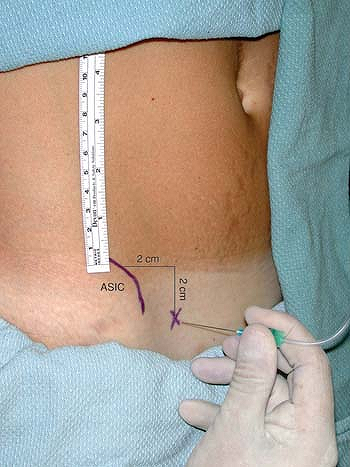Ilioinguinal and Iliohypogastric Nerve Blocks
Editors: Chelly, Jacques E.
Title: Peripheral Nerve Blocks: A Color Atlas, 3rd Edition
Copyright ©2009 Lippincott Williams & Wilkins
> Table of Contents > Section VII – Pain Blocks > 72 – Ilioinguinal and Iliohypogastric Nerve Blocks
72
Ilioinguinal and Iliohypogastric Nerve Blocks
Nashaat N. Rizk
Harinarayan Balasubramanian
For the ilioinguinal nerve block, with the patient in supine position,
palpate the most medial part of the ASIS. Mark a point 1 cm medial and
1 cm caudal to the most medial part of the ASIS.
For the iliohypogastric nerve block, the point of needle
insertion is 1 cm medial and 1 cm cephalad to the most medial part of
the ASIS (Fig. 72-1).
insertion is 1 cm medial and 1 cm cephalad to the most medial part of
the ASIS (Fig. 72-1).
For both procedures, the area is prepared with Betadine
(Purdue Pharma L.P., Stamford, CT). Next, a 50-mm insulated needle
attached to a 10-mL syringe and a nerve stimulator is introduced
through the skin. The nerve stimulator is set up to deliver 1.5 mA. The
needle is advanced with continuous aspiration in an oblique angle
toward the pubic symphysis. Once paresthesia is elicited, the needle
position is adjusted to maintain the paresthesia with a current of 0.4
mA. After negative aspiration for blood, the local anesthetic mixture
is slowly injected. The needle is then removed, and pressure is applied
to reduce the risk of postblock ecchymosis and hematoma.
(Purdue Pharma L.P., Stamford, CT). Next, a 50-mm insulated needle
attached to a 10-mL syringe and a nerve stimulator is introduced
through the skin. The nerve stimulator is set up to deliver 1.5 mA. The
needle is advanced with continuous aspiration in an oblique angle
toward the pubic symphysis. Once paresthesia is elicited, the needle
position is adjusted to maintain the paresthesia with a current of 0.4
mA. After negative aspiration for blood, the local anesthetic mixture
is slowly injected. The needle is then removed, and pressure is applied
to reduce the risk of postblock ecchymosis and hematoma.
P.455
 |
|
Figure 72-1. Point of needle insertion.
|
Suggested Readings
Bridenbaugh PO, Wedel DJ. The lower extremity: somatic blockade. In: Cousins MJ, Bridenbaugh PO. Neural blockade in clinical anesthesia and management of pain, 3rd ed. Philadelphia: Lippincott-Raven, 1998.
Waldman SD. Iliohypogastric nerve block. Atlas of interventional pain management, Philadelphia: WB Saunders, 1998.
Waldman SD. Ilioinguinal nerve block. Atlas of interventional pain management, Philadelphia: WB Saunders, 1998.
